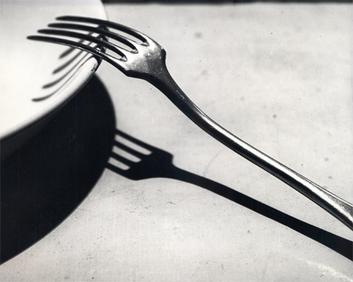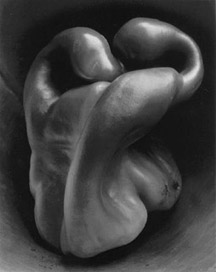Andre Kertesz & Edward Weston
 This photograph was taken by Andre Kertesz, named 'The Fork'. Kertesz was a Hungarian photographer. Born in 1894 and died in 1985. The subject matter of the photograph is simply a fork and a plate. I think that there is a deeper meaning in the photograph, as Kertesz has managed to capture simple, everyday objects which we as humans take for granted and has transformed it into something which will stay in the mind for a long time. In my opinion the meaning behind the fork, is that it could represent all the things we take for granted, but when captured in a single moment, we see how it is much more than a simple fork, as clearly we use it to eat, but when we do it brings us joy and how some who don't have a fork will never understand what that joy is. On first looking at it, you don't really quite understand what it is about, and in a way that is the beauty of it, because it makes you think, but then on looking at it and trying to understand you can see that maybe it has some form of a hidden meaning.
This photograph was taken by Andre Kertesz, named 'The Fork'. Kertesz was a Hungarian photographer. Born in 1894 and died in 1985. The subject matter of the photograph is simply a fork and a plate. I think that there is a deeper meaning in the photograph, as Kertesz has managed to capture simple, everyday objects which we as humans take for granted and has transformed it into something which will stay in the mind for a long time. In my opinion the meaning behind the fork, is that it could represent all the things we take for granted, but when captured in a single moment, we see how it is much more than a simple fork, as clearly we use it to eat, but when we do it brings us joy and how some who don't have a fork will never understand what that joy is. On first looking at it, you don't really quite understand what it is about, and in a way that is the beauty of it, because it makes you think, but then on looking at it and trying to understand you can see that maybe it has some form of a hidden meaning.
The frame of the photograph can be considered a close up, with the fork being placed sideways on the plate, this creates really good shadows. The contrast in the image is really amazing, how he managed to get the right amount of darkness to compliment the lightness of certain areas. He uses the shadows to his advantage as they are really dark in comparison to the whiteness of the plate and the grey fork. I really like how he has arranged the image , everything seems to be in the right place as if they do belong there.
In some ways I think the image was planned, maybe to provoke a response from the audience, but then it could also have been spontaneous. Kertesz used very dramatic lighting to cast does really dark shadows, the light seems to have been shone from the above which give the photograph that really nice contrast. I don't think Kertesz did anything much to his photography work, he seems to keep everything true to the original, there doesn't seem to be any cropping in his images or any form of editing as the photograph was taken in 1928 which meant he didn't have any form of modern technology to do anything really fancy to his work.
I think this work makes me really think that there are always two sides to everything. As even though the fork is light and contrasted the shadow it casts is very dark, which could represent us as human begins having two sides, and I think that even though the fork is an inanimate object it too has to sides. As even though its main function is for eating it can also cause harm if used in the wrong way.

Kertesz's, the fork in comparison to Weston's pepper are quite different. The fork has a very defined form and is very crisp in focus. The lighting is very harsh and very precise, with the shadows falling in the right places. However Weston's 'Pepper' is more contemporary and a lot softer. With having such soft lighting the photograph almost looks like it was made with charcoal. The smudging of the background also adds to this.
I prefer Kertesz photograph as I like that fact that it is very crisp and in focus. The dark areas and light are clearly shown with the use of such high contrast.Whereas Weston's pepper is more fluid and not as contrasted, instead blending the colours together.

No comments:
Post a Comment